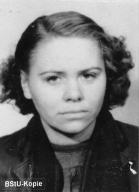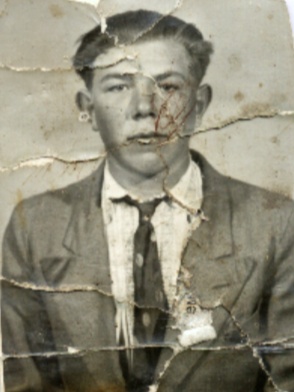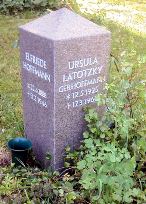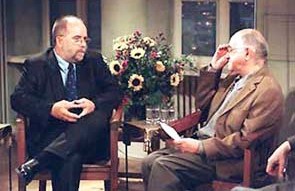Everyone who grew up in East Germany (aka GDR) is familiar with the
novel "Naked Among Wolves" by Bruno Apitz who tells the story of
Jerzy Zweig, the "Child of Buchenwald". It was obligatory reading in
(the communist run) East German schools. But who in the GDR knew
that there were children living in Buchenwald, Sachsenhausen und the
other former concentration camps after WW II as well. Children, who
were born there, lived there - and sometimes even died there. They
were as innocent as Jerzy Zweig and all the other prisoners in the
Nazi concentration camps.
I am one of these children. I was born in 1948
in the Soviet special camp of Bautzen. At the age of only eight
weeks my mother and I were moved to the camp at Sachsenhausen where
I spent my first years until 1950 - together with many other
children. With the dissolution of the camps the women and children
were handed over to the East German authorities and sent to the
prison at Hoheneck. Here the children were separated from their
mothers for many years and, in some cases, forever.
Since the fall of the Berlin Wall I have been
compiling a history of these events and was able to find more than
70 children with stories similar to mine. Not all of them survived
that time, but since 1998 I have been organizing annual reunions at
the former camps and prisons which today serve as memorials.
History can be best understood when one can
quote from real-life personal experiences. Therefore I will describe
a true case for condemnation and what could be better than my own
story.
After the war my mother lived with my
grandmother in Berlin. She was 19, almost 20 years old and survived
the hard times quite well. That is until early 1946. When she
returned to the flat one day in February 1946, she found my
grandmother dead. In the end, at her age of 58 she had not been able
to fend off two soviet men who had first raped then strangled her.
Both the culprits were still lying drunk and fast asleep in the
flat. My mother went to the police in good faith and reported the
murder, after all the war had been over for almost a year and law
and order had been re-established. Perhaps she also felt sure about
it, as she lived in the American Sector of Berlin. The State
Prosecutor took the case anyway and began to make enquiries.
Three weeks later, on March 25th, the
Headquarters of the Soviet Military Command in Berlin requested the
file, which since then has disappeared. At the State Prosecutor's
Office there is only a memo of the request and a note that the file
was never returned. Only five weeks later my mother was arrested by
Soviet soldiers in Senftenberg and sentenced to 15 years hard labour
by Soviet Military Tribunal on July 11th 1946 for alleged spying for
a foreign intelligence service.
In order to serve her sentence she was sent to
the special camp at Torgau. Here she got to know a young Ukrainian,
who was serving as a guard there. The guard came from the small town
of Grischki in the Ukraine, where he had been born in 1925 as the
youngest of five children. He started school at six, but had to
leave after two years to work on an a farm as a shepherd boy. At
this time in the Ukraine there was a wave of hunger of unbelievable
proportions due to Stalin's methods of forced collectivisation,
which claimed about 7 million lives. By making him work at this age
the parents could ensure that the boy survived. When the German Army
invaded the Soviet Union he was 15 years old and had direct and
close experiences of the horrors of war. In 1943, at the age of 18,
he was brought to Germany as forced labour. First of all he had to
work in the town of Brandenburg in a tank factory. In August 1943,
together with other forced labourers, he escaped from there, but was
recaptured on the German-Polish border and handed over to the
Gestapo. He was imprisoned in the Gestapo-prison in Schneidemühl and
thereafter in Deutschkrone, where he was set free at the end of the
war by the Red Army.
Following his release he was first threatened
with the fate of all Soviet forced labourers, as a traitor to the
fatherland he should be shot. By a lucky circumstance he managed to
avoid this fate. Just behind the front a new unit of stragglers from
the Red Army was being formed, so instead of being shot he was
pressed into the Army. However, first of all he had to go into a
military hospital, where he still was at the end of the war, then
after a short period of training was posted as Sergeant of the Guard
to the special camps of Buchenwald and later Torgau. Former
prisoners describe him as a shy and pleasant chap. Despite his
previous experiences this man fell in love with a prisoner at
Torgau, my mother. Although both of them must have known the risk
they were taking, a relationship developed between them. Whenever it
was possible, they met. Therefore, during his watch, he was always
leaving his post, which was then unmanned, whilst my mother was
always breaching the rules and regulations so that she might be put
into solitary confinement as a punishment.
All this came out at the trial before a
Military Tribunal of the Internal Troops on February 28th 1948, a
copy of which I managed to get hold of a few years ago, as
eventually their relationship resulted in my mother becoming
pregnant, of which the camp administration became aware. Someone
betrayed them however and my father was arrested and also imprisoned
in Torgau. Both of them underwent numerous interrogations but my
mother refused to name the father right to the end. However, he
confessed to the relationship in order to bring an end to the matter
and in the hope of a light sentence. For the crime of having sexual
relations with a German woman he was sentence to 6 years in the
Gulag and deported to Siberia. He left Torgau on 17 April 1948 with
900 other prisoners and was deported to a camp in Sukhobesvodnaye in
the USSR. He and my mother never saw each other again.
One day later I was born. A few days prior to
the birth my mother had been transferred to Bautzen, where I came
into the world. When I was 6 weeks old, we were send to
Sachsenhausen. We lived there in two barrack huts at the edge of the
camp in miserable conditions. One of three prisoners died,
regardless of whether they where old or young. It was left up to the
camp authorities to decide how to deal with the fact that there were
children present. We had no cloth, no nappies, no shoes or anything
else. One woman told me that we used clothes from people who died.
The mothers had to make do somehow and so it is no surprise to me
that not all of the children did survive.
In 1950 the special camps in the GDR were shut
down. But the nightmare story didn’t end for all mothers and
children. Nearly all the prisoners who belonged to the so-called
special contingent, amongst them 11 mothers with their children,
were released, but those who had been sentenced by Soviet Military
Tribunal were handed over to the DDR authorities to complete their
sentences. It was freezing cold when we left Sachsenhausen in
February 1950. Over 1.100 women and 30 children and babies were
taken, some by lorry, some on foot, to the railway station at
Oranienburg. They were transported in cattle trucks, with no heating
in the icy cold, lying on the bare straw, with insufficient food and
toilet facilities, to the town of Stollberg, from where they were
taken to Hoheneck prison located high above the town. For the women
it must have been a dreadful journey into an uncertain future. What
this journey really must have been like can be ascertained from the
final report of the People's Police. It does not just contain the
actual details about the exact number of persons handed over to the
GDR authorities, but there are also statements about the transport
arrangements. First of all we can find out from German sources
something about the existence of the children in the camps. „About
30" it says in the report by the People's Police regarding the
transport on 11 February 1950 and a further two women with suckling
children were checked in at Waldheim as being on the transport
before it was diverted to Hoheneck. No more was mentioned but all
the same there were many pregnant and heavily-pregnant women amongst
them. So it was that on 6 March, that is 4th weeks later, Johanna R.
gave birth to her son Gert in Hoheneck. Then on March 26th he was
followed by Viktor Harald and then on April 6th by the child of
Hildegard B. who died the same day. The child of Lieselotte H. also
died in the same year in Hoheneck. On April 12th a son was born to
Erika R., on June 4th Heinz-Rüdiger, on July 1st Dorothea, and so
on. The last one of those who had arrived from Sachsenhausen to give
birth was Elfriede L. on November 13th 1950. The child was
still-born and therefore not officially registered but a
hand-written note made on the prisoner's card kept in the prison.
When these women, alongside the approximately
30 babies or small children, who, in the space of a few days, had
arrived in Hoheneck from other camps, were admitted to the prison it
was completely overextended. Children had not been catered for in
prisons in the GDR, so the prison had a problem when it took over
those sentenced by Soviet Military Tribunal. They could not release
the mothers as the power of disposal of the women so sentenced lay
in the hands of the Soviets until 1954. They were unable to make a
ruling solely about the children, who had not been sentenced, but
were „appendages" to the women. A solution was sought and it was
probably Ellen Kuntz from the Land administration of the SED in
Saxony who found this solution. At least she was named in the
records of the People's Police as having been responsible for the
following: One day small buses drove up to the prison and then
several things happened: some women were told that the children had
to be examined by a doctor, or had to be photographed and whilst the
women were waiting in their cells, the children were led out of the
prison and loaded onto the buses. Later, the mothers themselves had
to put the children onto the buses; this was frequently done by
force. At this time the youngest child was just eight weeks old and
the eldest 3 years.
Without any sort of consideration mother and
child were torn apart and parted for years. All the women I
questioned found this a massively traumatic experience that only
healed years later, a long time after their release from prison.
These actions had been instigated by the then State Secretary for
Ministry of the Interior Hans Warnke, and carried out on February
28th 1950 via the Mother and Child prison governess and in the
ministry for Work and Health by Käthe Kern. For all the mothers,
including mine, the world fell apart.
The state of the women after they had been
parted from their children was described in a moving report by a
member of the Evangelical Church in 1953:
„Amongst the women who had been robbed of their
children was a Mrs. D. from Sachsenhausen. Her small daughter had
died in Sachsenhausen. Shortly afterwards her friend gave birth to a
child but died shortly after the birth. Frau D. took the small girl
to the nursery and looked after her lovingly. She had a small
picture of her own daughter, which someone had drawn for her on a
piece of paper. She was much attached to this picture and kept it
hidden away as drawings of this kind were forbidden in the camp.
After the child she had adopted had been taken away from her, the
guards also took the picture of her own daughter. Fran D. suffered a
nervous breakdown. The despairing cries of the woman could be heard
all day long even outside the prison."
I do not know how much the loss hurt my mother.
She did not say very much about it later. From the records of the
prison, which were made about her, it emerges, just how much she
missed me. Was she, as I can gather from the documents I have
managed to acquire in the meantime, in the beginning always full of
resistance to her tormentor, as can be seen from the punishment
book, of the prison, where all the talk is about rebelliousness
towards the guards, but this resistance was broken down more and
more with time. Added to that, as with all the prisoners, her health
slowly deteriorated, due to long years of under nourishment. In the
end her resistance was broken and, like all the others she went
around during the day in silence. As she stated in her personal
record written for the prison on her release: „After my release I
want to work in a mine or some other like occupation and thereby
ensure a secure future for my son..... [and] in doing so, also prove
that I am a full person." I think she was a full person her whole
life long.
The children were taken to a hospital in
Leipzig. The report of the then matron of the hospital lies in the
archives of the deacon of the Evangelic Church of Germany in Berlin.
She herself fled to the West in 1951, and in January 1953 wrote
about her experiences. So, in early 1950 she had received
instructions to install a children's ward in her hospital
immediately, and to expect 20-30 small children that very evening.
The hospital on Waldstrasse at that time had 350 beds. The hospital
did not cater for babies.
She succeeded in procuring the most necessary
items such as nappies, blankets, milk bottles and beds and made one
storey of the hospital into a children's wing. Late in the evening
the next day the first 10 children aged between 9 months and 3 years
arrived. The accompanying officer told her that the children did not
have any names and should be handled under the heading „Children of
the Land government”. She was forbidden to raise index cards about
them. Apart from that she was to ensure that no word of this was
made public.
On the following day the matron of the hospital
tried to acquire ration cards for the children. At first the ration
office refused to issue ration cards for children with no names. She
then managed to get some metal plates with a number for each child
from the People's Police, which were hung round the necks of the
older children and on the beds of the babies. Only then was the
ration office prepared to issue ration cards and later tickets for
shoes for the children, as none of them had proper shoes. They had
primitively-fashioned little shoes made from canvas. The name
“Sachsenhausen” had been sewn into the children's socks.
After a few days a further delivery of another
15 children arrived. The matron of the hospital seized the moment
when she was alone with the police doctor to ask urgently for the
names of the children. She realised that a child could die, and that
the manager of the cemetery would never accept a body without a
name. That made everything clear to the doctor, who placed the files
at her disposal for an hour. Humidly she wrote down the names at the
same time establishing the fact that the mothers were prisoners in
Hoheneck prison near Stollberg. The files also stated the crimes the
mothers had committed - illegal border crossing, spying, sabotage.
The mothers had all been previously imprisoned in Sachsenhausen.
Nearly every child had a bundle, in some cases
with adult things and frequently with a heartrending letter from
the mother, written on torn scraps of paper with a piece of plaster
or coal with details of the habits of the child as well as a request
to treat it kindly. There were also wishes for the child to be
handed over to certain relatives. Tips such as „Sascha has only ever
slept in my arms, be good to him,” or „Be nice to Dag, he has never
known a bed”, these and other such deeply moving requests were
frequent. The staff of the hospital tried to keep up with
everything, but at the beginning it was very difficult, because the
children were crying night and day for their mothers. It was also
difficult to calm the babies, as some of them had only just been
weaned. Five of the smallest children, whom the mothers could not
wean so quickly, without avoiding doing them harm, did not come on
the transport. They were later taken to children's home in Dresden.
Naturally the existence of the children could
not remain a secret and after a little while the grandmother of one
of the children turned up from Gera demanding the child be handed
over to her. The matron of the hospital had to refuse this request,
but reported it immediately to the Police President. Very soon
afterwards a second incident occurred. A father from Hamburg arrived
and demanded his child. He had been arrested with his pregnant wife
in 1946 and taken to Sachsenhausen. He had been released in January
1950, but his wife and boy had been taken to Stollberg in February
1950. At the hospital in Leipzig he went at once into the garden and
called his son. The little one ran to him immediately and they threw
their arms around one another. But he too had to leave the hospital
without his child, and was lucky, one could now say, to be pushed
back across the border to the West under guard by the People's
Police.
After these two incidents “the children of the
government” could no longer be concealed. The matron of the hospital
was now permitted to write letters to the relatives and very soon
thereafter 9 grandparents or other relatives arrived to take the
children away. The father from Hamburg sent a sister from the
evangelical mission to pick up his son. At the end there were 16
children left in Leipzig hospital, which the Police President
scornful said no-one wanted. Eventually, in November 1950 there were
transferred to three children's homes in Leipzig.
On the instructions of the Police President
each child was given a change-of-address and ration card with their
full names. The Waldstrasse hospital served as the last place of
residence and also the place of birth. The children were termed as
orphans. The whole exchange of letters with the authorities and the
relatives was handed over to the Police President. According to a
decision made by the Ministry of the Interior in 1952 these children
were to remain in the GDR.
The mothers in prison were told that their
children were now in a children's home, that they were well and that
the State would be responsible for their upbringing, by which an
upbringing in the socialist spirit was guaranteed. In some cases the
mothers were permitted to write to their children occasionally, but
any visit by relatives of the family living in freedom was
prohibited.
Now and again during their term of imprisonment
some mothers received photos of their child, which had probably been
taken by supervisors in the children's homes on the instructions of
the State. The women said they were only allowed to keep these
photos for a few hours to look at before they had to be handed back
and placed in their files.
From this point onwards all traces of the
children disappear, as, in the meantime, all documents concerning
them cannot be found. In none of the town-, district- or
state-archives, nor in the Federal archives, to whom I wrote, could
any documents concerning the homes be found. In response to a
request the mayor of Naunhof wrote to tell me that the files
concerning the children had been burnt in 1966/67. According to him,
this happened: ,As they were in unusable, mouldy condition". Much
the same happened with the documents for all the other children's
homes.
From 1954 the GDR received the right from the
Soviet Union to dispose of those sentenced by Soviet Military
Tribunal and they began to release them in installments. In July
1955 my mother's sentence was reduced to 10 years and on 31 March
1956 she was released to the Evangelical Church in Berlin-Teltow,
the only address that she could still give. From there, she went to
West Berlin and registered herself at the refugee camp in
Marienfelde where she met a man who had returned after having been a
prisoner of war in Russia for eleven years. They got married that
summer.
From
the very first day, my mother tried to fetch me to the West. She
wrote to the Red Cross, the German government, the East German
president, Wilhelm Pieck and I don’t know who else. But nobody
wanted to or was able to help her. Eventually she was directed by
the Central Organisation for Political Refugees from the East to
organisations in West Berlin; the Research Commission for
Independent Lawyers (UfJ) and the Struggle against Inhumanity (KgU)
led by Rainer Hildebrandt. There they planned my abduction. A
middleman was supposed to talk to me on my way to school in Seiffen
and then bring me to West Berlin. In order to prove that I was
really her child, she needed a birth certificate. But my mother
couldn’t produce one, as we only existed as an entry on our mothers’
prison record cards. I only got a birth certificate after I had
arrived in the West. This was only possible after several of the
former female prisoners confirmed that they had witnessed my birth
in Bautzen.
It was
only 45 years later that I found out from the Stasi (East German
secret police) files how my mother had managed to suddenly and
indeed legally fetch me to her in the West. In 1954 (I am not
exactly sure how long I was there) I was not in a home but staying
with a family. The daughter was a trainee at the children’s home and
her parents wanted to take me in. It is all just a fuzzy memory as
after all it was the first time that I was not in a camp, a prison
or a children’s home and I couldn’t get my head round it. But it was
only a short time. The prison leadership informed my mother that a
family wanted to take me in. She found out the name and address of
the family from a questionnaire that gave my current whereabouts.
She was very desperate and afraid that she was going to lose me
forever. The only a way out she saw was to work as a spy for the MfS
(Ministry of State Security)! She signed a contract and I went back
to the children’s home.
Just before her release in March 1956 she was
handed over to the “Soviet friends” with written permission from
Erich Mielke. Because she spoke Russian and was an interpreter, she
was given the job of spying on the Russian exiles organisation and
the Orthodox Church in West Berlin. But there was also a problem –
she was not trusted. Comrade Süß of the Ministry of State Security
wrote in his report “Without the existence of firm pledges, we
cannot consider her entirely trustworthy”. I am not sure who came up
with the solution, the KGB or the Ministry of State Security but my
mother was sent to the West and I had to stay in East Germany as a
“firm pledge”. A conversation with the head of my children’s home
took place in which she was given the instruction not to release me
to anyone without reference to an agreement of the Ministry of State
Security and to keep quiet about it.
As
already discussed, my mother secretly tried to get me out of East
Germany but without success. She did not know that the Ministry of
State Security knew about everything nor that the Stasi (state
police) had its eye on the Research Commission for Independent
Lawyers and other groups. In desperate letters to her commanding
officers First Lieutenant Hüttner and Second Lieutenant Süß, she
begged that I be allowed to come to her but without success.
It was
only in 1957 that the KGB and the Ministry for State Security were
convinced by her good work and at the age of almost 9 I was at last
allowed to go to her. But that was a mistake and shortly afterwards
all contact to her was stopped. As Colonel Trubnikow of the KGB
wrote, all her reports were made up and nothing she had done could
be turned into any concrete. But the “firm pledge”, me, had been
lost.
Since then
I have led a so called normal life.
We lived in a really quite
part of Berlin. Her husband adopted me a few years later and I took
the same surname as my mother. I remained the only child and as such
was spoilt. I studied, married and today have children and
grandchildren. Since 1990 I have worked as a historian and training
consultant. In the meantime in the course of my work I have found
more than 80 children, who were born in soviet special camps and
some of them meet their mothers now and again. We exchange
remembrances and try to help each other.
So, finally, there just remains the question of
what happened to a Russian sergeant, who had been sentenced to six
years in a prison camp in Siberia for his love of a German prisoner.
He survived the Gulag and was released into freedom after six years.
However, he had no money and therefore was unable to return to his
mother and sisters in his home town.
They
were still alive and he had not seen them since he had been
transported off to Germany in 1943. They had written to tell him
that his father and one of his sisters had starved to death during
the war. So he remained where he was and started work for the
railway. During the time he had spent in the camp he had got to know
a woman, whom he then married. Together they had four children.
He had not thought about a certain German
prisoner for a long time, nor about the child that he had never
seen. In all the years I too had never looked for him. I lived in
the belief that he was dead, as my mother had been told he had been
sentenced to death for his crime. It was 1997, when I received some
documents from Moscow by the German Red Cross, that I found this was
not true. I began to search for him and I was very lucky to find out
where he was living.
In 1999
I visited him for the first time in Russia. In 2000 he returned to
Germany on a visit for the first time after all the years, because
he wanted to see his grandchildren. It was not an easy visit for him
and he had hesitated a long time before making it.
After that all he only had one more wish: After
my grandmother had reached the incredible age of 102 he wants to
live one year longer so he can tell everyone this story.
His wish didn't come true; he died on Christmas
morning 2004 in the age of 79.

My Mother 1955

My Father 1943 in Germany

My Mother and Grandmother

Camp Buchenwald 1946

Kinderheim Naunhof 1951

The
Last Picture 1957

1999 in Russia

With My Daughter on the way to my mothers grave


2001 in Germany




as ebook here avalible

